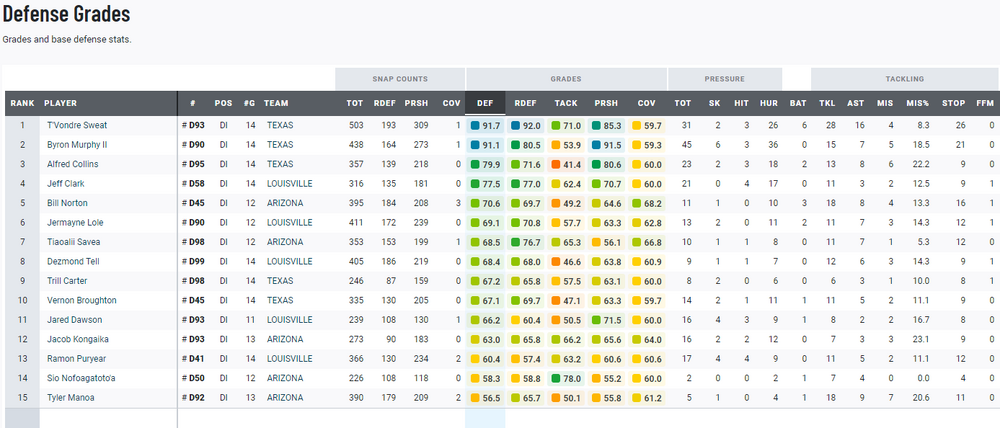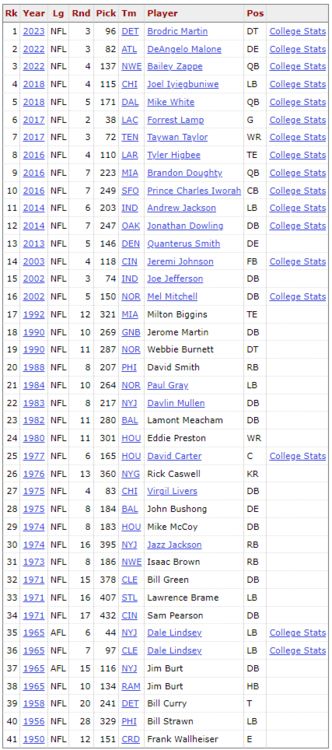-
Posts
8816 -
Joined
-
Last visited
-
Days Won
11
Content Type
Profiles
Forums
Store
Downloads
Recruiting - 2020
2019-2020 Football Season
Football
Entertainment
Sports
News and Business
Cloak Room
Transfer Portal
Recruiting
Events
Posts posted by Hiphopopotamos
-
-
Just now, Gene Parmesan said:
Did he get injured at ASU? His stat line in 2019 / 2020 seems productive enough to get him drafted.
Per Gerry, Lole was on NFL radars following the 2020 season but has had three surgeries on triceps and elbow injuries.
-
 3
3
-
-
-
-
Productive 7th year guy on the DL. Pretty pretty pretty good.
-
 4
4
-
-
Apparently Nahlin confirmed a transfer commit, but not Johnny Bowens. Who else is Texas in on?
-
 1
1
-
-
10 hours ago, Thiefery said:
This is Brian Kellner's (BKs) channel right? He's a cool guy, he left his Houston sports gig to return to Austin and try this. This picture reminds me of the netzero days... site that had free internet...
Even Netzero wasn’t that visually intrusive.
-
 3
3
-
-
22 minutes ago, Laxtonto said:

-
OU offered the brother.
-
 1
1
-
 5
5
-
-
Little guy - but stud DB.
-
 2
2
-
 3
3
-
-
2 hours ago, BurntOrange&White said:
Will Harris be the GM or player personnel director? Or will part of the restructure be
GM - Brandon Harris
Player Personnel Director - John Michael Jones
Director of Recruiting - ????
One of the 9.95'ers - might have been Nahlin - said that Alabama came calling for Brandon Harris recently.
-
6 minutes ago, Spider2YBanana said:
The way he talked on OTF he discovered Moro Ojomo, so who knows?
Moro Ojomo played at Katy. He wasn't 'discovered', he was just a late-riser because he graduated high school at 12 years old.
This isn't a Josh Jacobs situation where literally no one had heard of the kid until his shit started getting posted on twitter.
-
 3
3
-
-
- Popular Post
- Popular Post
-
 9
9
-
 1
1
-
Sark responds
-
 4
4
-
-
4 minutes ago, Hookem2147 said:
From Bobby:
I am told to expect to see some restructuring in the Texas personnel department as part of this move.
Wonder if we might be adding a GM-type role too?
Was just going to ask - I don't think we have that title, but Glasscock was essentially that, no?
In the NFL you generally have a Director of Pro Personnel and a Director of College Scouting who roll up to the General Manager. Is the new way of college football to have a High School Recruiting and a College/Transfer Portal guy who roll up to a General Manager?
-
 3
3
-
-
-
- Popular Post
- Popular Post
-
 12
12
-
 3
3
-
 1
1
-
-
19 minutes ago, Newy25 said:
No, the assistant line coach is not the one responsible for coaching the line. He’s not in charge. It’s like the analyst position. Helping out? Yes. Responsible for scheme and scouting? No.This is dumb. Coaching is collaborative.
-
 8
8
-
-
-
1 minute ago, Vertigo said:
One thing I did find interesting in this interview is the fact that 3 different defensive coordinators kept him on staff. I guess that's something? That's all I got.
If we're looking for positives - he was a holdover through 3 different DCs.
Hired by Vic Fangio
After one year as ADL coach, chosen to coach the DL at the Senior Bowl.
-
-
I’m looking forward to judging his tweet game over these next few weeks. Follows, retweets, tweets - it will all be scrutinized by my trained eye.
-
 3
3
-
-
I know nothing about him other than Vic Fangio hired him - which is a check on the 'pro' side for me.
According to this video he was a hold-over at WKU through three different DCs.
-
 7
7
-
 1
1
-
-
Nahlin (IT) reporting that Joe DeCamillis is not expected back next season. Hes looking for a return to the NFL.
-
 1
1
-






2024 Texas Football Coaching and Support Staff Thread
in 🤫$9.95🤫
Posted
Unlimited Coaches May Soon Become a Reality:
https://theathletic.com/5482522/2024/05/10/college-football-coaching-staff-limits-rule/?source=emp_shared_article&redirected=1